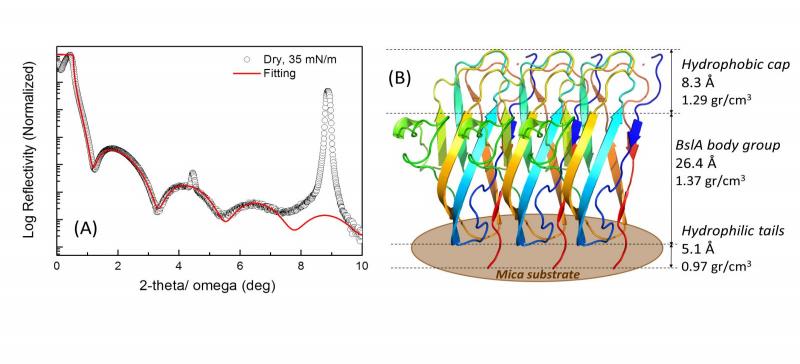 |
|
|
Application example: X-ray reflectivity on a biofilm protein on mica |
||
Biofilms are densely packed communities of microorganisms capable of protecting the growth of microbes. Biofilms contain proteins as one of their major constituents. Bacillus subtilis lipase LipA (BslA) protein possesses a remarkable water-repellent “cap” [1], which modifies the physicochemical properties of surfaces and interfaces that, for example, may protect a bacteria colony from antimicrobial agents [2,3]. The study of the molecular structure of biofilms is therefore essential to new strategies for designing antimicrobial agents and surface-active biofilms. Here, we measure the biofilm structure using x-ray reflectivity (XRR) to characterize the biofilm’s thickness and density to infer film morphology and structure.
 Figure 1. (A) X-ray reflectivity pattern of a BslA monolayer on a mica substrate prepared at the surface pressure of 35 mN/m at the air/water interface. (B) Representation of the BslA monolayer on the mica, showing the three-layers by the XRR analysis. Taken from Ref. A Narrow Amide I Vibrational Band Observed by Sum Frequency Generation Spectroscopy Reveals Highly Ordered Structures of a Biofilm Protein at the Air/Water Interface Chem. Commun., DOI: 10.1039/C5CC05743D Figure 1. (A) X-ray reflectivity pattern of a BslA monolayer on a mica substrate prepared at the surface pressure of 35 mN/m at the air/water interface. (B) Representation of the BslA monolayer on the mica, showing the three-layers by the XRR analysis. Taken from Ref. A Narrow Amide I Vibrational Band Observed by Sum Frequency Generation Spectroscopy Reveals Highly Ordered Structures of a Biofilm Protein at the Air/Water Interface Chem. Commun., DOI: 10.1039/C5CC05743D
|
The XRR pattern for the BslA protein/mica sample was analyzed by using a three-layer fitting model: a hydrophobic cap, a BslA body and a tail on the mica substrate (solid red line, Figure 1A). The best fitting to the measurements yielded three regions: (1) a 8.3-Å thick hydrophobic cap with density 1.29 g/cm3, (2) a 26.4-Å thick BslA body with density 1.37 g/cm3, and (3) a 5.1-Å thick tail with density 0.97 g/cm3. According to the XRR result analysis the occupied area is 21 x 21 Å2/molecule, which shows the biofilm is even more densely packed than what is expected from the lateral dimensions of the molecule in the crystal structure. The obtained total thickness and values of the density are consistent with the crystal structure of BslA [1] at a full surface coverage that orients vertically with the hydrophobic cap facing up. This XRR results confirm the formation of a densely packed structure of BslA at the air/water interface.
References
[1] L. Hobley, et al. , Proc Natl Acad Sci U S A, 2013, 110(33), 13600-13605
[2] J. Willey, J. Schwedock, R. Losick, Genes and Dev, 1993, 7(5), 895-903
[3] M. A. Elliot, N. J. Talbot, Curr Opinion Microbiol, 2004, 7(6), 594-601